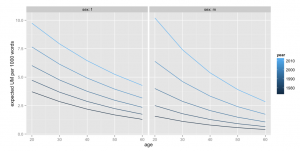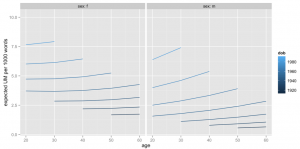Age, period, um, cohort
A recurring issue with trends over time is whether they are ‘age’ trends, ‘period’ trends, or ‘cohort’ trends. That is, when we complain about ‘kids these days’, is it ‘kids’ or ‘these days’ that’s the problem? Mark Liberman at Language Log has a nice example using analyses by Joe Fruehwald.
If you look at the frequency of “um” in speech (in this case in Philadelphia), it decreases with age at any given year
On the other hand, it increases over time for people in a given age cohort (for example, the line that stretches right across the graph is for people born in the 1950s)
It’s not that people say “um” less as they get older, it’s that people born a long time ago say “um” less than people born recently.
Thomas Lumley (@tslumley) is Professor of Biostatistics at the University of Auckland. His research interests include semiparametric models, survey sampling, statistical computing, foundations of statistics, and whatever methodological problems his medical collaborators come up with. He also blogs at Biased and Inefficient See all posts by Thomas Lumley »

